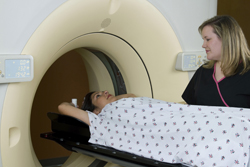Cheaper chips for PET radiopharmaceutical production
Radiolabelled molecules generally have a very short period of usefulness, requiring them to be produced on-site. The growing PET market needs require an alternative to the currently used expensive, bulky cyclotron devices to produce these radiopharmaceuticals or molecules. A project called 'Radiochemistry on chip' (ROC) was funded by the EU to develop a microfluidic device to replace the current technology. The project required collaboration between chemists, physicists and engineers, besides the incorporation of academic, industrial and public health institutions. Prior to building a functional prototype, a full analysis and optimisation of all the components was performed to see if the device was feasible. This involved testing all components for functionality and safety with both non-radioactive and radioactive reagents. Once each module had been successfully tested, several microfluidic chips were manufactured using different designs and materials. A prototype device was constructed, incorporating several chips and a radiation detector for added safety. Early testing results indicated that the yield of the new chip system was comparable to the current standard with higher efficiency and better control. This semi-continuous system had better speed and flexibility. PET is an increasingly important technique for medical research and diagnosis. The development of an efficient and safe alternative to radiolabelling with a cyclotron represents an important breakthrough for this technology.





